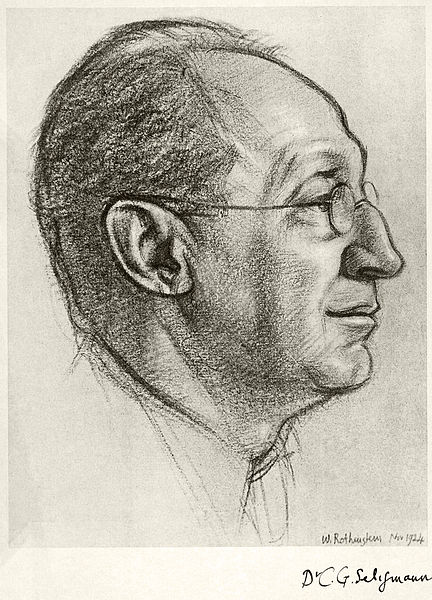
Charles Gabriel Seligman (1873 – 1940), image: William Rothsteinעברית: ויליאם רוטשטיין, CC BY 3.0, via Wikimedia Commons
On December 24, 1873, British physician and ethnologist Charles Gabriel Seligman was born. Seligman‘s main ethnographic work described the culture of the Vedda people of Sri Lanka and the Shilluk people of the Sudan. He was a proponent of the Hamitic hypothesis, according to which, some civilizations of Africa were thought to have been founded by Caucasoid Hamitic peoples.
Charles Gabriel Seligman – Background
Seligman was born into a middle class Jewish family in London, UK, the only son of wine merchant Hermann Seligmann and his wife Olivia (Charles shortened his name to Seligman after 1914). His interests in natural science became early manifest: while still at a preparatory school, he began to collect butterflies and, at the house of a boy friend, carried out chemical experiments.[3] He studied medicine at St Thomas’ Hospital.Charles Gabriel Seligman studied medicine at St Thomas’ Hospital. He later worked as a physician and pathologist and then served the 1898 Cambridge University expedition to the Torres Strait. Later expedition included New Guinea, Ceylon, and Sudan. Seligman served as chair of Ethnology at the London School of Economics from 1913 to 1934.
Ethnographic Work in Africa
Charles Seligman is probably best known for his ethnographic work on the races of Africa. He recognized four major distinct races of the African continent: Bushmanoids (Bushmen), Pygmies, Negroids, and Caucasoids (Hamites). Further, the Hottentots, according to Seligman are a mixture of Bushmanoid, Negroid and Hamitic. As a staunch proponent of the Hamitic theory, in his work Seligman asserts that Hamitic Caucasoid North and Northeast Africans were responsible for introducing non-Semitic Afro-Asiatic languages (Berber-Cushitic-Egyptian) into Africa, as well as civilization, technology and all significant cultural developments.
Hamites
He did acknowledge varying degrees of Negroid admixture amongst the Hamitic groups, but emphasized throughout his major works the essential racial and cultural unity of the various Hamitic peoples. In his Some Aspects of the Hamitic Problem in the Anglo-Egyptian Sudan (1913), he wrote that the Northern and Eastern Hamitic “groups shade into each other, and in many parts a Negro admixture has taken place, nevertheless, culturally if not always physically, either division stands apart from its fellow.”
The Hamites in general, and the Northern Hamites in particular, he asserted, have close “kinship with the European representatives of the Mediterranean race“. Drawing from Coon, Seligman also discusses fairer features observed amongst a minority of Berbers or Northern Hamites, such as lighter skin, golden beards and blue eyes. Races of Africa, however, notably questions the belief held by some anthropologists in the early 20th century that these fairer traits, such as blondism, were introduced by a Nordic variety. Seligman’s most famous work Races of Africa is regarded the first major published work in English on the ethnography of Africa, widely regarded as an “ethnological classic”.
Charles Gabriel Seligman died from infective endocarditis in a nursing home at Oxford on 19 September 1940, at age 66.[3]
Selected works:
- Melanesians of British New Guinea (1910)
- The Veddas (1911) with Brenda Seligman
- Some Aspects of the Hamitic Problem in the Anglo-Egyptian Sudan (1913)
- Races of Africa (1930, 1939,1957,1966)
- The Pagan Tribes of Nilotic Sudan (London: Routledge, 1932) with Brenda Seligman
A Theory You’ve Never Heard Of | Michael Robinson | TEDxUniversityofHartford, [7]
References and Further Reading:
- [1] Charles Seligman Short Biographical and Works at Britannica
- [2] Charles Seligman Biographical at the Royal Society
- [3] Myers, C. S. (1941). “Charles Gabriel Seligman. 1873–1940“. Obituary Notices of Fellows of the Royal Society. 3(10): 627–646.
- [4] Catalogue of the Seligman papers at the Archives Division of the London School of Economics.
- [5] C. G. Seligman, The Races of Africa, London, 1930
- [6] Charles Seligman at Wikidata
- [7] A Theory You’ve Never Heard Of | Michael Robinson | TEDxUniversityofHartford, TEDx Talks @ youtube
- [8] Timeline of British Ethnologists, via Wikidata and DBpedia





